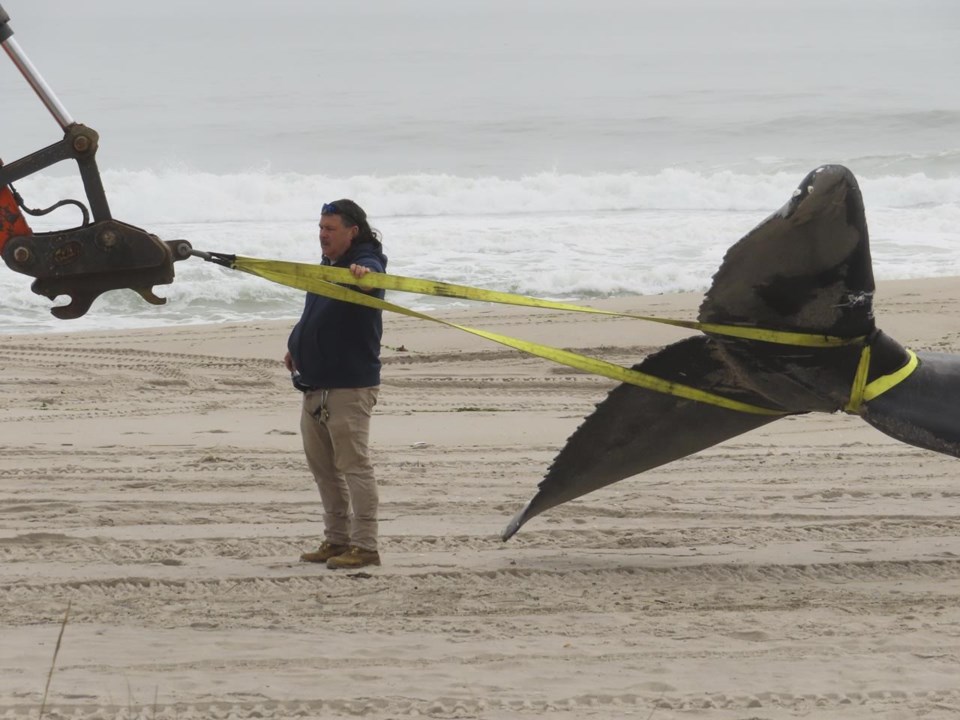SEASIDE PARK, N.J. (AP) — As dead whales continue to wash ashore on the U.S. East Coast — and particularly the Jersey Shore — officials and academics are planning a wide array of monitoring and research aimed at preventing or minimizing harm to whales and other marine life during construction and operation of offshore wind farms.
A dead whale washed ashore Thursday in New Jersey, a day after another was found in New York amid a continuing wave of whale deaths along the East Coast. Twenty-five of the animals have died since Dec. 1, according to the National Oceanic and Atmospheric Administration.
A research and monitoring initiative announced last year by New Jersey environmental and utility regulators is launching numerous projects to establish a baseline of current ocean conditions, with plans for monitoring while wind farms are built and operated.
The $26 million program is funded — but not carried out — by the offshore wind companies Orsted and Atlantic Shores, which are required by the state to pay for the research as part of their projects.
Similar wind-related research is being carried out by states from Maine to South Carolina, officials said.
The research was announced well before a spate of whale deaths became politicized, with opponents of offshore wind blaming the deaths on site preparation work for wind farms off New Jersey and New York. Various elected officials are pushing for a pause or a total halt to offshore wind projects, citing the whale deaths.
But three federal scientific agencies — the National Oceanic and Atmospheric Administration, the Bureau of Ocean Energy Management, and the Marine Mammal Commission — say there is no evidence linking offshore wind activities to whale deaths.
The federal government has been studying whale deaths since it declared an “unusual mortality event” involving humpbacks in 2016. Since then, 186 of the animals have died between Maine and Florida, with a high of 34 in 2017.
The New Jersey work includes placing listening devices on the ocean floor to record the presence of whales and other marine mammals in a specific area, and deploying an undersea glider equipped with sensors that can hear whale calls. It also includes tracking the movement of various fish species and using environmental DNA to tell which animals have been in specific areas of the ocean.
Some of the efforts are already underway, including a sound recorder operated by the Woods Hole Oceanographic Institute on a buoy off Atlantic City, while others are set to begin as soon as next month.
“We have the opportunity to get the lay of the land,” said Kira Lawrence, of the state Board of Public Utilities, who gave an update this week on the projects. “It's important that we get a handle on what is out there and how is it changing right now. We can get a sense of when and where whales are around project areas."
Other work involved in the initiative includes the development of a special dredge for surf clams that can maneuver more easily in tight spaces around wind farms, supporting a regional multi-state wildlife study, and the possible use of wind turbine platforms as monitoring stations for wildlife and environmental conditions.
The update on the research work came amid a continuing wave of whale deaths along the East Coast.
Necropsies were conducted on 13 of the 25 whales that have washed ashore since Dec. 1, revealing that ship strikes were the likely cause of at least eight of the deaths, said NOAA spokesperson Andrea Gomez. The agency is awaiting the results of microscopic tissue samples on the remaining animals, she added.
The breakdown of deaths by species is: 18 humpback whales between New York and North Carolina; 3 sperm whales between New York and Florida; two North Atlantic right whales in North Carolina and Virginia; one sei whale in North Carolina and one minke whale in New York, according to NOAA.
New York has several similar research projects underway, including the use of miniature transmitting tags for birds and bats near offshore wind farms, a study of how sea birds might interact with wind turbines, and creation of a database to incorporate anglers' knowledge into offshore wind decisions.
New Jersey projects not yet approved for funding, but which are envisioned, include sea turtle tagging to monitor their movements, and expanding studies of birds and bats.
During an online presentation of the initiative Monday by state officials, opponents of offshore wind renewed complaints about the wind turbines' visibility from shore and voiced fears that wind projects will harm or kill wildlife.
“I just want to make sure we don't permanently remove these beautiful animals from our coastline,” said Randall Snyder, a radiologist from Harvey Cedars on Long Beach Island, one of several hotbeds of local opposition to offshore wind.
___
Follow Wayne Parry on Twitter at www.twitter.com/WayneParryAC
Wayne Parry, The Associated Press



